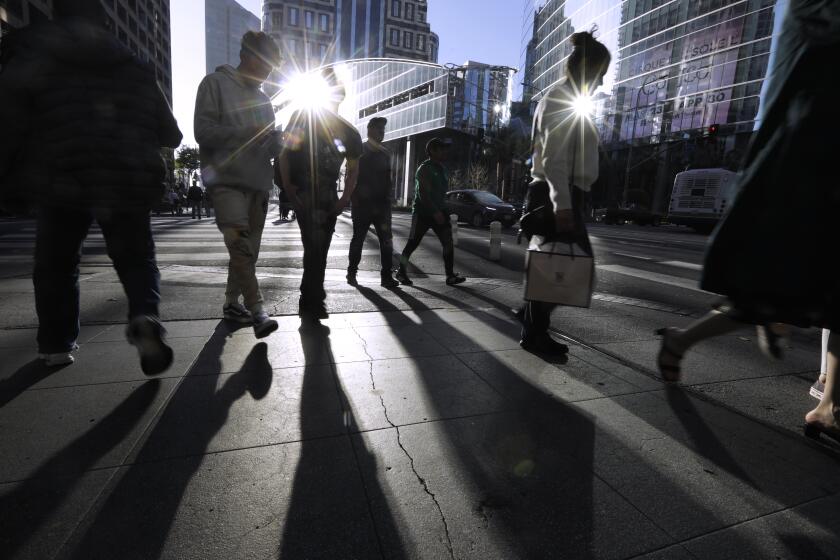Opinion: Will you need the latest COVID booster? It depends

- Share via
As the Biden administration prepares for the federal COVID-19 public health emergency to end on May 11, the new normal is markedly better than the earlier phase of the pandemic in which we lost more than a million American lives. We’ve gone from the 2021 peak of an estimated 3,000 Americans dying daily from the infection to about 250 a day now. But this “normal” still includes more than 30,000 COVID-19 deaths since the beginning of 2023, and the virus remains a leading cause of fatality in the U.S. This is not acceptable.
We face confusing realities: The pandemic’s acute phase is over, but COVID remains a significant cause of death. New variants always loom, one of the latest being XBB.1.16 — nicknamed Arcturus by some on social media — which recently reached L.A. Any long-term approach to mitigate the impact of COVID-19 will require periodic boosters — yet as of March, fewer than 1 in 5 eligible Americans got the booster that was made available in September, suggesting that interest in the shots has dipped alongside the virus’ toll.
The Food and Drug Administration recently amended its authorizations for Pfizer and Moderna’s mRNA vaccines, prompting the Centers for Disease Control and Prevention to modify its COVID-19 vaccine recommendations. Wading through these changes offers a window into our next stage of confronting COVID: adapting as vaccine technology evolves, emphasizing protections for high-risk people and maintaining vaccination as a preventive measure.
Arcturus, also known as XBB.1.16, has also attracted attention after reports linking it to what has been a rare COVID-19 symptom: pink eye.
The newest available mRNA vaccine is the bivalent shot, which contains two strains of the virus instead of the single strain in the original monovalent version. The FDA discontinued use of the monovalent vaccine because in the agency’s assessment and analysis of independent data, the bivalent shot provides better protection than the monovalent vaccine.
As a result, the CDC now recommends that everyone get at least one dose of the bivalent vaccine whether or not they’ve already had one or more doses of the monovalent vaccine (which is no longer allowed in the U.S.). However, the agency currently says that among adults, only higher-risk people — specifically those age 65 or older and immunocompromised individuals — should be allowed to receive additional bivalent vaccine doses. For children younger than 6, multiple doses are still recommended, but the appropriate number varies by a child’s age and vaccine history.
These nuanced recommendations make sense right now. They simplify the vaccine schedule for most people at a time when the U.S. has widespread population immunity, so focusing on high-priority groups over the general population is an efficient use of public health resources.
People with weak immune systems require additional vaccine doses to achieve the same level of protection as others. Older individuals remain at much higher risk of death and hospitalization compared with younger ones, meaning that ensuring high vaccination rates for those age 65 or older will be essential to reduce deaths, hospitalizations and other dire outcomes such as long COVID. And it is reasonable to protect children under 6 years old with multiple vaccine doses rather than multiple exposures — which is the other way to shore up immunity, but comes with the risk of severe illness.
Dropping protections such as free tests and Medicaid continuous coverage will leave many uninsured and undocumented people without access to care for COVID-19.
But the current moment isn’t guaranteed to last. Group-level protection could diminish, especially as immunity wanes or if a new variant emerges that can better evade existing immunity. Infection rates can surge quickly, meaning public health recommendations — and their communication to the public — have to be nimble. Guidance to maintain high vaccination rates among health workers, for example, will mitigate the impact of a sudden increase in COVID-19 transmission on the health system.
And we should be prepared to keep adjusting to newer, better vaccines. The Biden administration recently announced it will accelerate development of the next generation of COVID vaccines and treatments under the $5-billion-plus “Project Next Gen.” That’s a worthy aim.
The benefits of the bivalent vaccines continue to outweigh their risks in all groups, and they remain very useful in reducing severe disease and death. But they’re far less effective in lowering overall infections from the Omicron family of viruses. They also require boosters to offer the most protection, and they’re continuously at risk of being tripped up by new, more lethal or more transmittable variants. Substantial investment in vaccines that block infection and, ideally, that work irrespective of the variant is the only path to sustainable control of COVID-19.
We are living with this virus now. We have to rely on forward-looking, science-based vaccine policies to help us control its continuing impact.
Saad B. Omer is the director of the Yale Institute for Global Health, a professor in medicine and public health and an adjunct professor of nursing at Yale University. He will start as the founding dean of the Peter O’Donnell School of Public Health at UT Southwestern in June. @SaadOmer3
More to Read
A cure for the common opinion
Get thought-provoking perspectives with our weekly newsletter.
You may occasionally receive promotional content from the Los Angeles Times.












